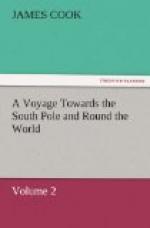All the land birds we saw consisted of a few small larks, nor did we meet with any quadrupeds. Mr Forster indeed observed some dung, which he judged to come from a fox, or some such animal. The lands, or rather rocks, bordering on the sea-coast, were not covered with snow like the inland parts; but all the vegetation we could see on the clear places was the grass above-mentioned. The rocks seemed to contain iron. Having made the above observations, we set out for the ship, and got on board a little after twelve o’clock, with a quantity of seals and penguins, an acceptable present to the crew.
It must not, however, be understood that we were in want of provisions: we had yet plenty of every kind; and since we had been on this coast, I had ordered, in addition to the common allowance, wheat to be boiled every morning for breakfast; but any kind of fresh meat was preferred by most on board to salt. For my own part, I was now, for the first time, heartily tired of salt meat of every kind; and though the flesh of the penguins could scarcely vie with bullock’s liver, its being fresh was sufficient to make it go down. I called the bay we had been in, Possession Bay. It is situated in the latitude of 54 deg. 5’ S., longitude 37 deg. 18’ W., and eleven leagues to the east of Cape North. A few miles to the west of Possession Bay, between it and Cape Buller, lies the Bay of Isles, so named on account of several small isles lying in and before it.
As soon as the boat was hoisted in, we made sail along the coast to the east, with a fine breeze at W.S.W. From Cape Buller the direction of the coast is S. 72 deg. 30’ E., for the space of eleven or twelve leagues, to a projecting point, which obtained the name of Cape Saunders. Beyond this cape is a pretty large bay, which I named Cumberland Bay. In several parts in the bottom of it, as also in some others of less extent, lying between Cape Saunders and Possession Bay, were vast tracks of frozen snow, or ice, not yet broken loose. At eight o’clock, being just past Cumberland Bay, and falling little wind, we hauled off the coast, from which we were distant about four miles, and found one hundred and ten fathoms water.
We had variable light airs and calms till six o’clock the next morning, when the wind fixed at north, and blew a gentle breeze; but it lasted no longer than ten o’clock, when it fell almost to a calm. At noon, observed in latitude 54 deg. 30’ S., being then about two or three leagues from the coast, which extended from N. 59 deg. W. to S. 13 deg. W. The land in this last direction was an isle, which seemed to be the extremity of the coast to the east. The nearest land to us being a projecting point which terminated in a round hillock, was, on account of the day, named Cape Charlotte. On the west side of Cape Charlotte lies a bay which obtained the name of Royal Bay, and the west point of it was named Cape George. It is the east point of Cumberland Bay,




